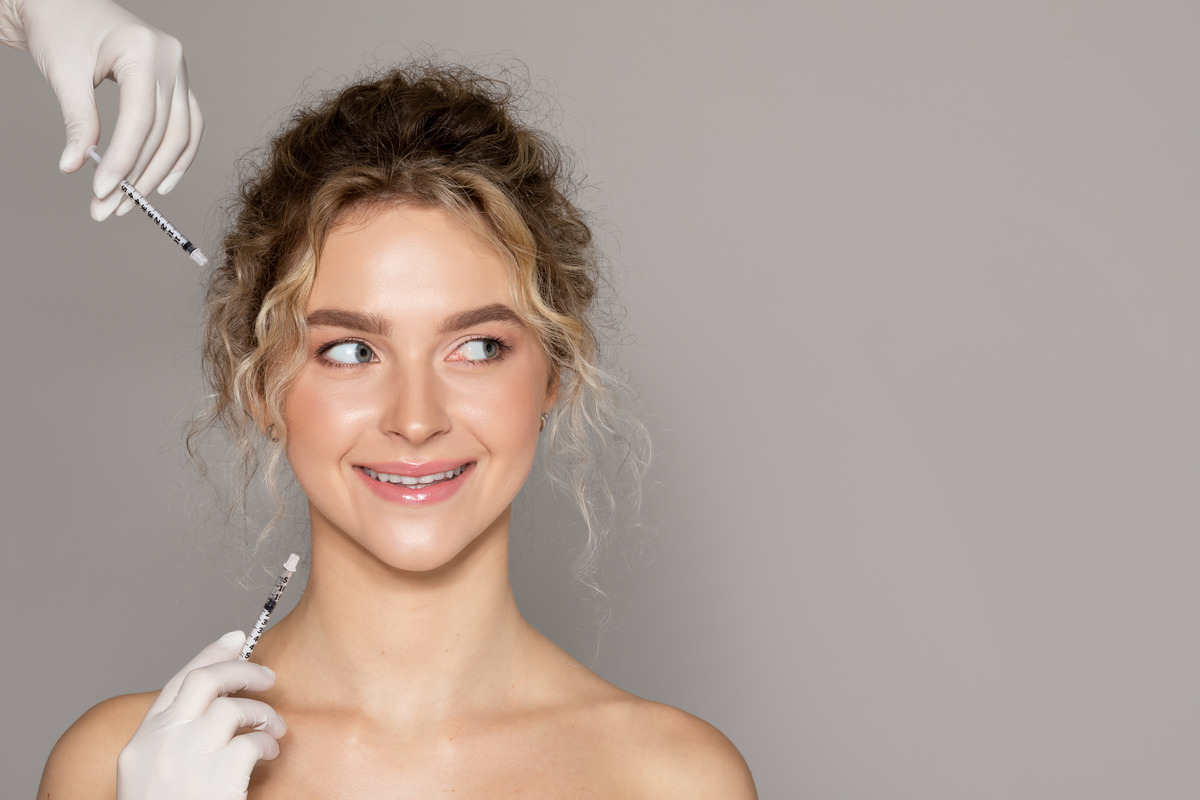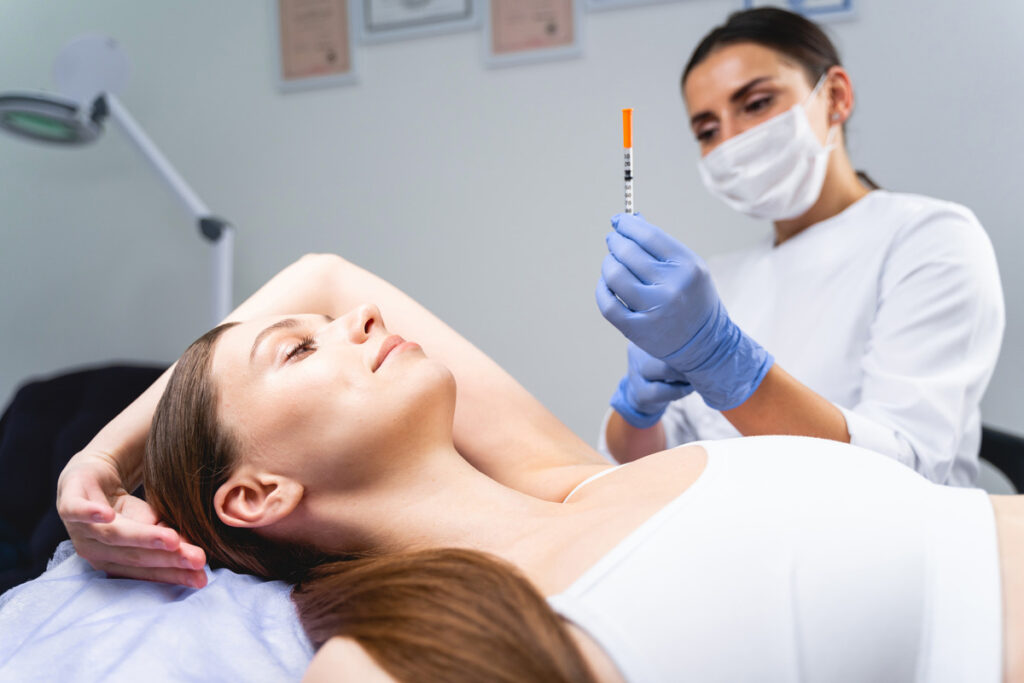Botox, also known as onabotulinumtoxinA, is a leading choice for reducing the appearance of wrinkles and severe frown lines in the glabellar region and around the eyes, commonly known as crow’s feet lines.
Botox has become the number 1 selling product of its kind since receiving FDA approval for cosmetic use in 2002 for the treatment of moderate to severe:
– Frown lines between the eyebrows
– Crow’s feet
– Forehead lines
Over 100 million vials have been sold in the USA since 2002. Botox’s use is supported by over 4,700 peer-reviewed scientific publications.
In your first Botox treatment, you should understand the process to begin preparing for Botox and it will also allow you to have realistic Botox expectations.
This article will discuss what to expect as you prepare for your first Botox treatment.
Initial Considerations Before Your Treatment

Determining Your Suitability for Botox
- Age affects Botox candidacy because it works best on muscles that become stronger and more active with age such as the erector spinae, quadriceps, gastrocnemius, abdominals, obliques, forearm muscles, trapezius, rhomboids, and facial muscles, leading to the formation of wrinkles.
People who should get Botox have moderate to severe frown lines, crow’s feet, and forehead lines and are adults starting 18 to 65 years old. However, Botox can address concerns for people of various ages therefore, ensure to inquire if your age will affect your candidacy during your Botox consultation.
- It works best for dynamic wrinkles caused by muscle movements that become more prominent with age and they become most noticeable when you frown, squint, or raise your eyebrows. Static wrinkles are present even when your face is relaxed and Botox may not be the best option in such a case but be sure to inquire during your Botox consultation.
Do not take Botox if:
- Are allergic to any of the ingredients in BOTOX.
- Had an allergic reaction to any other botulinum toxin product such as Myobloc, Dysport, or Xeomin.
- Have a skin infection at the planned injection site.
- Are being treated for urinary incontinence and have a urinary tract infection (UTI)
- Are being treated for urinary incontinence and find that you cannot empty your bladder on your own.
Choosing the Right Provider
- The provider should be a certified Botox injector.
- Their experience with Botox procedure.
- The rates of patient satisfaction.
- The provider’s professional affiliations.
- Their communication style.
What you need to know when assessing and choosing a Botox specialist:
- Prepare for the consultation with a list of questions.
- Review credentials.
- Assess the style of communication. Ask yourself these questions:
- Do they listen to your concerns?
- Do they explain the procedure and answer your questions?
- Do they make you feel respected and valued?
- Is there a sense of trust and openness throughout the consultation?
- Review testimonies on platforms like RealSelf, Google, Healthgrades, Zocdoc, and local directories.
- Assess the clinic’s environment.
Preparing for the Treatment
What to Do Before Your Appointment
Medications
Stop using blood-thinning medications such as aspirin, ibuprofen, and other NSAIDs at least two weeks before your appointment to reduce the risk of bleeding.
Consult your provider about stopping prescription anticoagulants or blood thinners such as warfarin as part of your Botox preparation and also avoid supplements that increase the risk of bleeding, including ginkgo biloba, garlic, and vitamin E.
Skin Care preparations
Avoid excessive sun exposure, harsh skincare products, exfoliating treatments, retinol, or glycolic acid products before the appointment.
Dietary considerations
- Eat at least 1.5 grams of protein per kilogram daily.
- Drink 1.5 L of water daily.
- Avoid alcohol consumption.
What to Bring to Your Appointment
- A valid ID for age verification such as a driver’s license, state ID card, military ID, and valid U.S. passport.
- A list of your current medications, supplements, and medical conditions.
- Medical history.
During the Botox Treatment
This is what happens during Botox treatment
- The Botox procedure takes 5-15 minutes.
- The provider will cleanse your face with an antiseptic solution and then inject Botox directly into the targeted muscles. You may feel a prickling sensation during the injections.
Post-Treatment Care
Immediate Aftercare
This list includes Botox aftercare and Botox recovery tips.
- Don’t rub the treated areas for 12 hours after Botox treatment.
- Maintain an upright position for 3-4 hours.
- Don’t don’t lie down or apply pressure after the injection.
- Avoid activities that increase blood flow to the face for 24 hours.
- Sleep on your back for at least 2 nights following treatment to avoid putting pressure on the injected areas.
Long-Term Care and Follow-Up
- Noticeable results become visible in 1-2 days.
- Full effects typically last 3-4 months.
- Botox helps relax muscles to prevent the return of fine lines.
- Effects can last 3-12 months and retreatment is recommended at this time but your muscles may train themselves to contract less and treatments can be spaced out over longer periods.
- You will need to schedule Botox follow-up appointments depending on how quickly your body metabolizes the product if you want to maintain Botox results.
- Your provider can advise you on the best timing for touch-up treatments to improve Botox longevity.
Testimonials and Success Stories
Here are some Botox testimonials and success stories from first-time Botox users on realself
A patient who has had Botox on her forehead, between eyebrows, upper eyebrow, crows feet, chin, masseter said Botox has helped lift her eyebrows, get rid of chin dimples, and reduce heavy jaws from over clenching. She said Botox has done a wonderful job balancing her face and making it more feminine.
Another patient visited a provider to address concerns about facial fat/collagen loss and slightly droopy sagging eyes. She reported that she had no bruising, just a little soreness which only lasted a day or two so no downtime at all. Her face felt lifted and fresher.
Another patient said she got her full face softwave treatment last March 2023 and didn’t really see a difference until she went back for her 3 month check up. She was 39 yrs old and was looking for a bit of a lift. She noticed small changes around the jaw and cheeks. She was thinking of getting it again as now being 40yrs old she could see a bit more laxity/ sagging on her face. She also added that the procedure does hurt for sure– but was just about tolerable. She just used the numbing cream- but if she did it again- maybe she’d also take a pain killer.
Conclusion
Botox treatment summary
Botox is a prescription medicine that is injected into muscles and used to improve the look of moderate to severe forehead lines, crow’s feet lines, and frown lines between the eyebrows in adults.
The process is quick, around 5-15 minutes. The provider will clean your face and inject the Botox into the areas you want treated. You can drive yourself home or go back to work afterward.
Right after, don’t rub the treated areas for 12 hours. Stay upright for 3-4 hours and avoid strenuous activity for 24 hours.
Effects can last 3-12 months and retreatment is recommended at this time but your muscles may train themselves to contract less and treatments can be spaced out over longer periods.
Final thoughts on Botox
Botox is safe and effective for enhancing your appearance and boosting confidence when done by an experienced professional. This guide provides all the key information to ensure a smooth first Botox experience.
FAQ Related To Botox Treatment
What should I know before my first Botox appointment?
You should avoid some medications, skin care preparations, and some foods and supplements and you should also know what to bring to your appointment.
What are the steps involved in the Botox treatment process?
- Consultation.
- Numb the skin using a topical numbing cream.
- Identifying and marking the treatment areas.
- Cleansing the area.
- Botox injection.
Are there any specific preparations I need to make before receiving Botox?
Yes, the article lists several medications to avoid, skin care preparations, and dietary considerations.
What can I expect during the Botox injection session?
The provider will cleanse your face with an antiseptic solution and then inject Botox directly into the targeted muscles. You may feel a prickling sensation during the injections.
How long does a typical Botox session last?
The Botox procedure takes 5-15 minutes.
What should I do immediately after my Botox treatment?
- Don’t rub the treated areas for 12 hours after Botox treatment.
- Maintain an upright position for 3-4 hours.
- Don’t don’t lie down or apply pressure after the injection.
- Avoid activities that increase blood flow to the face for 24 hours.
- Sleep on your back for at least 2 nights following treatment to avoid putting pressure on the injected areas.

